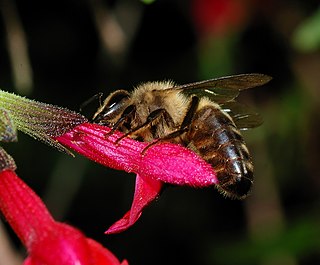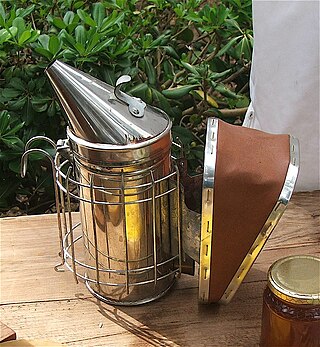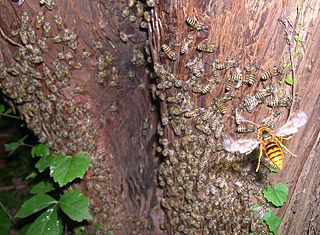
A honey bee is a eusocial flying insect within the genus Apis of the bee clade, all native to mainland Afro-Eurasia. After bees spread naturally throughout Africa and Eurasia, humans became responsible for the current cosmopolitan distribution of honey bees, introducing multiple subspecies into South America, North America, and Australia.

A beehive is an enclosed structure where some honey bee species of the subgenus Apis live and raise their young. Though the word beehive is used to describe the nest of any bee colony, scientific and professional literature distinguishes nest from hive. Nest is used to discuss colonies that house themselves in natural or artificial cavities or are hanging and exposed. The term hive is used to describe an artificial/man-made structure to house a honey bee nest. Several species of Apis live in colonies. But for honey production, the western honey bee and the eastern honey bee are the main species kept in hives.
Beekeeping is the maintenance of bee colonies, commonly in artificial beehives. Honey bees in the genus Apis are the most commonly kept species but other honey producing bees such as Melipona stingless bees are also kept. Beekeepers keep bees to collect honey and other products of the hive: beeswax, propolis, bee pollen, and royal jelly. Other sources of beekeeping income include pollination of crops, raising queens, and production of package bees for sale. Bee hives are kept in an apiary or "bee yard".

The Apis mellifera mellifera is a subspecies of the western honey bee, evolving in central Asia, with a proposed origin of the Tien Shan Mountains and later migrating into eastern and then northern Europe after the last ice age from 9,000BC onwards. Its original range included the southern Urals in Russia and stretched through northern Europe and down to the Pyrenees. They are one of the two members of the 'M' lineage of Apis mellifera, the other being in western China. Traditionally they were called the Black German Bee, although they are now considered endangered in Germany. However today they are more likely to be called after the geographic / political region in which they live such as the British Black Bee, the Native Irish Honey Bee, the Cornish Black Bee and the Nordic Brown Bee, even though they are all the same subspecies, with the word "native" often inserted by local beekeepers, even in places where the bee is an introduced foreign species. It was domesticated in Europe and hives were brought to North America in the colonial era in 1622 where they were referred to as the English Fly by the Native Americans.
Nosema apis is a microsporidian, a small, unicellular parasite recently reclassified as a fungus that mainly affects honey bees. It causes nosemosis, also called nosema, which is the most common and widespread of adult honey bee diseases. The dormant stage of N. apis is a long-lived spore which is resistant to temperature extremes and dehydration, and cannot be killed by freezing the contaminated comb. Nosemosis is a listed disease with the Office International des Epizooties (OIE).

Varroa destructor, the Varroa mite, is an external parasitic mite that attacks and feeds on honey bees and is one of the most damaging honey bee pests in the world. A significant mite infestation leads to the death of a honey bee colony, usually in the late autumn through early spring. Without management for Varroa mite, honey bee colonies typically collapse within 2 to 3 years in temperate climates. These mites can infest Apis mellifera, the western honey bee, and Apis cerana, the Asian honey bee. Due to very similar physical characteristics, this species was thought to be the closely related Varroa jacobsoni prior to 2000, but they were found to be two separate species after DNA analysis.

Varroa is a genus of parasitic mesostigmatan mites associated with honey bees, placed in its own family, Varroidae. The genus was named for Marcus Terentius Varro, a Roman scholar and beekeeper. The condition of a honeybee colony being infested with Varroa mites is called varroosis.

Varroa jacobsoni is a species of mite that parasitises Apis cerana. The more damaging Varroa destructor was previously included under the name V. jacobsoni, but the two species can be separated on the basis of the DNA sequence of the cytochrome oxidase I gene in the mitochondrial DNA.

Apis koschevnikovi, Koschevnikov's honey bee, is a species of honey bee which inhabits Malaysian and Indonesian Borneo, where it lives sympatrically with other honey bee species such as Apis cerana.

The Maltese honey bee, Apis mellifera ruttneri, is a subspecies of the western honey bee, endemic to the Maltese islands which are situated in the Mediterranean Sea.

A bee smoker is a device used in beekeeping to calm honey bees. It is designed to generate smoke from the smoldering of various fuels, hence the name. It is commonly designed as a stainless steel cylinder with a lid that narrows to a small gap. The base of the cylinder has another small opening that is adjacent to a bellow nozzle. Pumping of the bellows forces air through the bottom opening. The cylinder may also have a wire frame around to protect hands from burning. Some smokers have a hook on the side allowing the user to hang the device on the side of a beehive for easy access during an inspection or attach it to an ALICE belt when not in use.

The western honey bee or European honey bee is the most common of the 7–12 species of honey bees worldwide. The genus name Apis is Latin for 'bee', and mellifera is the Latin for 'honey-bearing' or 'honey-carrying', referring to the species' production of honey.

Commercial Beekeeping in the United States dates back to the 1860s.

Apis cerana japonica is a subspecies of the eastern honeybee native to Japan. It is commonly known as the Japanese honeybee. Analysis of mitochondrial DNA suggests that the ancestors of this subspecies came to Japan from the Korean Peninsula via Tsushima Island. Genetic differentiation between Japanese honeybees and Korean honeybees occurred about 20,000 years ago, which coincides with the separation of Japan's Tsushima Island from the Korean Peninsula due to sea level rise. They have been observed moving into urban areas in the absence of natural predators.

Apis cerana, the eastern honey bee, Asiatic honey bee or Asian honey bee, is a species of honey bee native to South, Southeast and East Asia. This species is the sister species of Apis koschevnikovi and both are in the same subgenus as the western (European) honey bee, Apis mellifera. A. cerana is known to live sympatrically along with Apis koschevnikovi within the same geographic location. Apis cerana colonies are known for building nests consisting of multiple combs in cavities containing a small entrance, presumably for defense against invasion by individuals of another nest. The diet of this honey bee species consists mostly of pollen and nectar, or honey. Moreover, Apis cerana is known for its highly social behavior, reflective of its classification as a type of honey bee.

Varroa sensitive hygiene (VSH) is a behavioral trait of honey bees (Apis mellifera) in which bees detect and remove bee pupae that are infested by the parasitic mite Varroa destructor. V. destructor is considered to be the most dangerous pest problem for honey bees worldwide. VSH activity results in significant resistance to the mites.
Beekeeping is first recorded in Ireland in the seventh century. It has seen a surge in popularity in modern times, with the membership of beekeeping associations exceeding 4,500. The median average number of hives per beekeeper is three hives, while the average honey output per hive is 11.4 kg. The growth in the practice has occurred despite increased pressures on bees and beekeepers due to parasites, diseases and habitat loss.

Beekeeping in India has been mentioned in ancient Vedas and Buddhist scriptures. Rock paintings of Mesolithic era found in Madhya Pradesh depict honey collection activities. Scientific methods of beekeeping, however, started only in the late 19th century, although records of taming honeybees and using in warfare are seen in the early 19th century. After Indian independence, beekeeping was promoted through various rural developmental programs. Five species of bees that are commercially important for natural honey and beeswax production are found in India.
Varroa underwoodi is a mite that feeds on honey bees. It is an external parasite of the western honey bee, Asian honey bee, A. nigrocincta, and A. nuluensisV. underwoodi has been found on multiple bee species in Southern Asia, though has only been found on the Asian honey bee in China. The smallest sized V. underwoodi was collected from Papua New Guinea from western honey bee hives.














